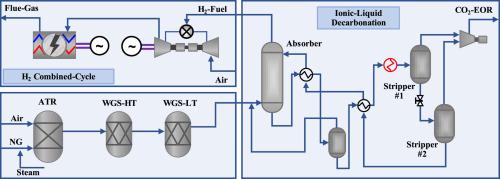Renewable and Sustainable Energy Reviews ( IF 16.3 ) Pub Date : 2020-06-29 , DOI: 10.1016/j.rser.2020.109995 Hudson Bolsoni Carminati , José Luiz de Medeiros , Gustavo Torres Moure , Lara Costa Barbosa , Ofélia de Queiroz F. Araújo

|
Autothermal reforming is an important pathway to hydrogen via fossil fuel decarbonization. Traditionally, the finishing step of hydrogen production via autothermal reforming consists of decarbonation via conventional aqueous-amine absorption which incurs a huge energy penalty due to high heat-ratio and low-pressure carbon dioxide stripping entailing costly compression for geological storage. This work proposes and assesses an alternative high-pressure temperature-swing hydrogen decarbonation that promotes stripping at high-pressure reducing carbon dioxide compression costs. Such new hydrogen decarbonation uses 1-Butyl-3-methylimidazolium bis(trifluoromethylsulfonyl)-imide ionic-liquid physical-absorption due to its solute affinity, low vapor-pressure, high thermal stability and low heat consumption for carbon dioxide stripping at high-temperature and high-pressure. Technical and economic aspects of the ionic-liquid temperature-swing decarbonation are evaluated and compared with the conventional aqueous-amine decarbonation. Results showed that high-pressure ionic-liquid stripping requires 5.5 times less heat to produce a high-pressure carbon dioxide stream and reduces 4.3 times its compression power. These results directly impact net power exportation of the combined-cycle hydrogen-fired power plant; i.e., the ionic-liquid gas-to-wire exports 35.6% more electricity than the aqueous-amine counterpart. Economically, the ionic-liquid gas-to-wire has 36% higher revenues, entailing a net value 2.5 times higher (US$ 390.2*106) and 5 years lower payback-time than the conventional aqueous-amine counterpart.
中文翻译:

通过高压汽提吸收离子液体[Bmim] [NTf 2 ]实现低排放的预燃气电
自热重整是通过化石燃料脱碳制氢的重要途径。传统上,通过自热重整生产氢气的完成步骤包括通过常规的水胺吸收进行脱碳,这由于高的热比和低压二氧化碳汽提而导致巨大的能量损失,这需要昂贵的地质存储压缩。这项工作提出并评估了替代的高压变温氢脱碳技术,该技术可促进高压下的汽提,从而降低二氧化碳的压缩成本。由于其溶质亲和力,低蒸气压,具有高吸收性和高吸收性,这种新的氢脱碳方法使用了1-丁基-3-甲基咪唑鎓双(三氟甲基磺酰基)-酰亚胺离子液体物理吸收。高温高压下汽提二氧化碳的热稳定性高,热量消耗低。对离子液体变温脱碳的技术和经济方面进行了评估,并将其与常规的水胺脱碳进行了比较。结果表明,高压离子液体汽提需要产生高压二氧化碳流的热量减少5.5倍,压缩功率降低4.3倍。这些结果直接影响了联合循环氢电厂的净电力输出;也就是说,离子液体气体到电线的输出比胺水溶液输出的电多35.6%。从经济上讲,离子液体气体到电线的收入增加了36%,净值比传统的水性胺胺高2.5倍(390.2 * 10 6)美元,投资回收期缩短了5年。











































 京公网安备 11010802027423号
京公网安备 11010802027423号